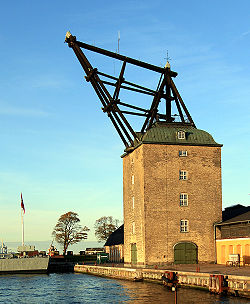Portal:Denmark
Welcome to the Denmark Portal! | ||||

|

|

| |
Denmark is the smallest and southernmost of the Nordic countries. Unified in the 10th century, it is also the oldest. Located north of its only land neighbour, Germany, south-west of Sweden, and south of Norway, it is located in northern Europe. From a cultural point of view, Denmark belongs to the family of Scandinavian countries although it is not located on the Scandinavian Peninsula. The national capital is Copenhagen.
Denmark borders both the Baltic and the North Sea. The country consists of a large peninsula, Jutland, which borders Schleswig-Holstein; many islands, most notably Zealand, Funen, Vendsyssel-Thy, Lolland, and Bornholm; and hundreds of minor islands often referred to as the Danish Archipelago. Denmark has historically controlled the approach to the Baltic Sea, and those waters are also known as the Danish straits.
Denmark has been a constitutional monarchy since 1849 and is a parliamentary democracy. It became a member of the European Economic Community (now the European Union) in 1973. The Kingdom of Denmark also encompasses two off-shore territories, Greenland and the Faroe Islands, both of which enjoy wide-ranging home rule. The Danish monarchy is the oldest existing monarchy in Europe, and the national flag is the oldest state flag in continuous use.
Selected biography

Karen von Blixen-Finecke (April 17, 1885 – September 7, 1962), née Dinesen, was a Danish author also known under her pen name Isak Dinesen. Blixen wrote works both in Danish and in English. She is best known, at least in English, for her account of living in Kenya, Out of Africa, and a film based on one of her stories, Babette's Feast.
Daughter of Ingeborg Westenholz Dinesen, and the writer and army officer Wilhelm Dinesen, and sister of Thomas Dinesen, she was born into a Unitarian aristocratic family in Rungsted on the island of Zealand, in Denmark, and was schooled in art in Copenhagen, Paris, and Rome. She began publishing fiction in various Danish periodicals in 1905 under the pseudonym Osceola, the name of the Seminole Indian leader, and possibly inspired by her father's connection with American Indians. From August 1872 to December 1873, Wilhelm Dinesen had lived among the Chippewa Indians, in Wisconsin, where he fathered a daughter, who was born after his return to Denmark.
Recently selected: Bertel Thorvaldsen - Rasmus Rask - Piet Hein
Selected picture

Selected article
Selected place
The museum buildings are organized into a small village of chiefly half-timbered structures originally erected between 1550 and the late 1800s in various parts of the country and later moved to Aarhus during the 1900s. There are several groceries, diners and workshops spread throughout the village with museum staff working in the roles of typical village figures i.e. merchant, blacksmith etc. adding to the illusion of a "living" village.
Categories
Denmark topics
Things you can do
- Expand stubs:
Geography stubs · People stubs · Denmark stubs in general
Help us extend these stubs and make them real articles!
- Categorize:
Help us categorize Denmark-related articles
- WikiProjects:
Have a look at WikiProject Denmark, WikiProject Faroe Islands, WikiProject Greenland and WikiProject Norse history and culture
- Noticeboard:
Have a look at the Danish Wikipedians' notice board
- Geotag:
Find coordinates for these locations and tag them: articles missing geocoordinate data
Related portals
Northern Europe
Other countries
Associated WikiMedia
The following Wikimedia Foundation sister projects provide more on this subject:
-
Commons
Free media repository -
Wikibooks
Free textbooks and manuals -
Wikidata
Free knowledge base -
Wikinews
Free-content news -
Wikiquote
Collection of quotations -
Wikisource
Free-content library -
Wikispecies
Directory of species -
Wikiversity
Free learning tools -
Wikivoyage
Free travel guide -
Wiktionary
Dictionary and thesaurus













